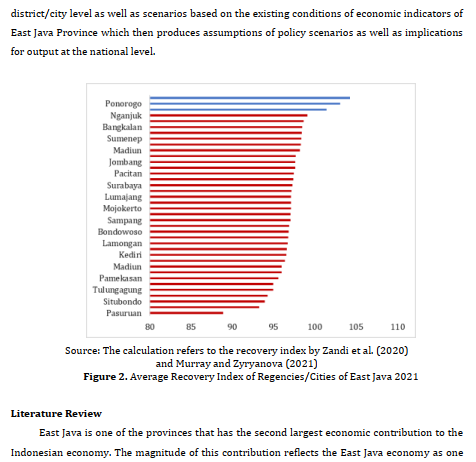Policy Scenario to Boost East Java Economic Recovery: Interregional Input-Output Analysis (IRIO)
DOI:
https://doi.org/10.12928/jampe.v2i1.6491Keywords:
Economic Recovery , Government Expenditure , Information and Communication, Investment, IRIOAbstract
Economic recovery post-COVID-19 is the major development agenda of the government at the central and regional levels. The contribution of this study is to identify, analyze, and provide strategic policy recommendations on the progress of economic recovery in East Java using Input-Output (IO) model. As one of the provinces with the 2nd highest economic contribution to the nation, East Java needs to develop a comprehensive economic recovery strategy to lift its economy to a higher position than the pre-pandemic level. First, the recommended policy scenario is based on the results of the calculation of the recovery index for the Province and Regency/City of East Java. Hereafter, using the 2016 Interregional Input-Output (IRIO) Table, this study recommends a stimulus policy scenario for investment and government spending in all sectors as a game changer that will accelerate East Java's economic recovery. Meanwhile, by sector, information and communication will be the main sectors that encourage the acceleration of economic recovery in East Java Province. Nevertheless, the stimulus in each policy scenario can be considered by the East Java Provincial Government according to the focus and objectives of economic recovery.
References
Amir, H. (2013). Economic Impact Analysis of the 2012 Indonesia Mineral-Export Tax Policy: A CGE Approach. International Journal of Economic Policy Studies, 8(1), 1–22. https://doi.org/10.1007/bf03405742
Baldwin, R., & Mauro, B. W. di. (2020). Economics in the Time of COVID-19. www.cepr.org
Bappenas. (2021). Pemutakhiran Rencana Kerja Pemerintah Tahun 2022.
Bonet-Morón, J., Ricciulli-Marín, D., Pérez-Valbuena, G. J., Galvis-Aponte, L. A., Haddad, E. A., Araújo, I. F., & Perobelli, F. S. (2020). Regional economic impact of COVID-19 in Colombia: An input–output approach. Regional Science Policy and Practice, July, 1–28. https://doi.org/10.1111/rsp3.12320
BPS. (2021a). Pertumbuhan Ekonomi Indonesia Triwulan IV-2020. In Badan Pusat Statistik (Issue 13). https://www.bps.go.id/pressrelease/2021/02/05/1811/ekonomi-indonesia-2020-turun-sebesar-2-07-persen--c-to-c-.html
BPS. (2021b). Tabel Interregional Input-Output Tahun 2016.
BPS Jawa Timur. (2021). Pertumbuhan Ekonomi Jawa Timur Tahun 2021. In Berita Resmi Statistik (Vol. 13, Issue 02).
Brodeur, A., Gray, D., Islam, A., & Bhuiyan, S. J. (2020). A Literature Review of the Economics of COVID-19. IZA Discussion Paper, 13411.
Fadinger, H., & Schymik, J. (2020). The Effects of Working from Home on Covid-19 Infections and Production A Macroeconomic Analysis for Germany. C.E.P.R. Covid Economics, April 2020.
Horridge, M., Yusuf, A. A., Ginting, E., & Aji, P. (2016). Improving Indonesia’s domestic connectivity: an inter-regional CGE analysis. ADB Papers on Indonesia, 17, 1–31.
Maria del Rio-Chanona, R., Mealy, P., Pichler, A., Lafond, F., & Doyne Farmer, J. (2020). Supply and demand shocks in the COVID-19 pandemic: An industry and occupation perspective. Oxford Review of Economic Policy, 36, S94–S137. https://doi.org/10.1093/oxrep/graa033
Miller, R. E., & Blair, P. D. (2009). Input-Output Analysis: Foundations and Extensions.
Murray, Ne., & Zyryanova, N. (2021). Tracking the Post-COVID-19 Economy: The COVID-19 Economic Recovery Index.
Osotimehin, S., & Popov, L. (2020). Sectoral Impact of COVID-19 : Cascading Risks. Opportunity and Inclusive Growth Institute Working Paper, 31.
Resosudarmo, B. P., Abdurohman, Yusuf, A. A., & Hartono, D. (2021). Spatial impacts of fiscal stimulus policies during the 2009 global financial crisis in Indonesia. Asia-Pacific Journal of Regional Science, 5(1), 305–326. https://doi.org/10.1007/s41685-020-00176-2
Resosudarmo, B. P., Yusuf, A. A., Barat, J., Hartono, D., Barat, J., & Nurdianto, D. A. (2011). Regional Economic Modelling for Indonesia: Implementation of IRSA-INDONESIA5. Journal of Indonesian Economy and Business, 26(3), 287–309. https://doi.org/10.22146/jieb.6259
Rifa’i, A., & Listiono, L. (2021). STRUCTURAL TRANSFORMATION AND POVERTY ERADICATION IN EAST JAVA (A PANEL DATA APPROACH OF 38 COUNTIES). Journal of Developing Economies, 6(1), 114. https://doi.org/10.20473/jde.v6i1.23080
Weisbrod, G., & Duncan, C. (2016). Integrating multiple economic analysis methods for more effective decision making: Three-dimensional framework. Transportation Research Record, 2597(2597), 99–107. https://doi.org/10.3141/2597-13
Yu, K. D. S., Aviso, K. B., Santos, J. R., & Tan, R. R. (2020). The Economic Impact of Lockdowns: A Persistent Inoperability Input-Output Approach. Economies, 8(4), 109. https://doi.org/10.3390/economies8040109
Zandi, M., Deantonio, D., & Colyar, M. (2020). Business Back-to-Normal Index.

Downloads
Published
Issue
Section
License
Copyright (c) 2023 Achmad Rifa'i, Doddy Purwoharyono, Fathia Khairunnisa

This work is licensed under a Creative Commons Attribution-ShareAlike 4.0 International License.










